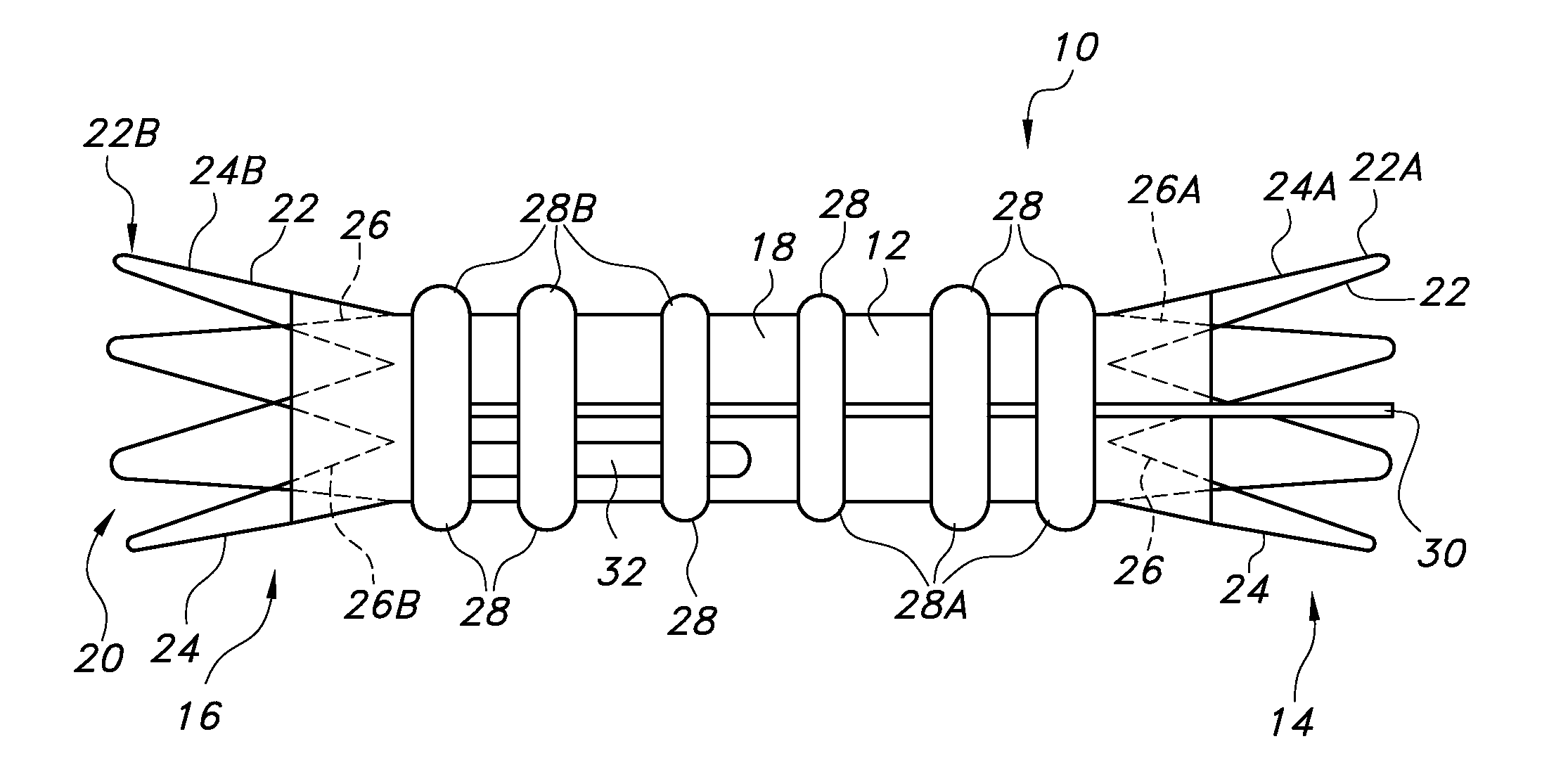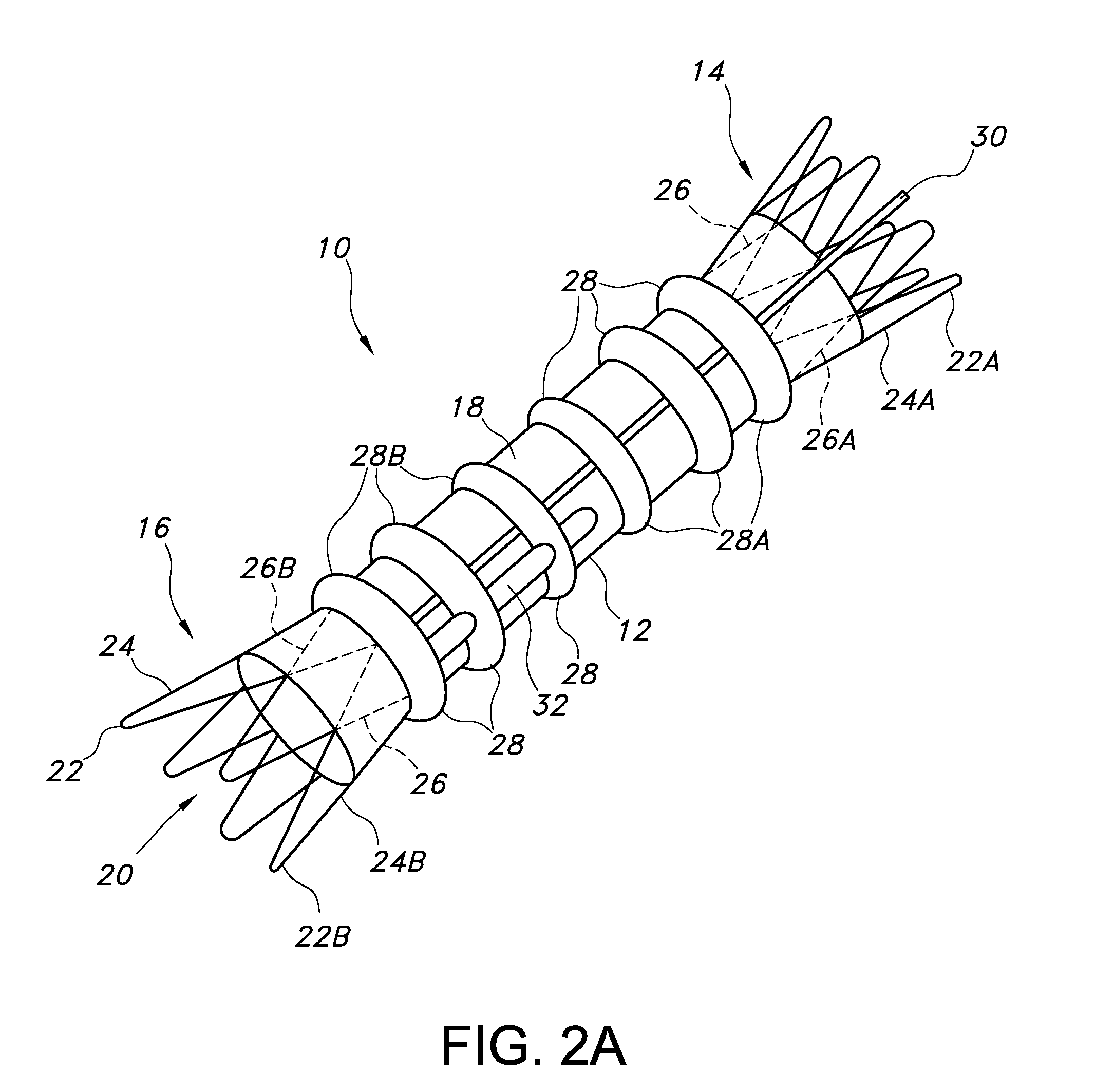Advanced kink resistant stent graft
a kink resistant, grafting technology, applied in the field of implantable devices, can solve the problems of relatively high morbidity and mortality rate of procedures for treating aortic aneurysms, generally regarded as involving higher risk and more difficulty
- Summary
- Abstract
- Description
- Claims
- Application Information
AI Technical Summary
Benefits of technology
Problems solved by technology
Method used
Image
Examples
embodiment 12
[0049]Some embodiments of main graft member 12 may include about 1 to about 8 circumferential inflatable channels disposed about the graft body 12. Some embodiments of the graft body 12 may include about 1 to about 4 longitudinal (or axial) inflatable fill channels 30 that may serve to connect the circumferential inflatable channels 28. Some embodiments of the circumferential channels 28 may extend a full circumference of the graft section upon which they are disposed, or they may extend only partially around the graft section upon which they are disposed. For the graft body embodiment 12 shown in FIGS. 1 and 2A, the network of inflatable channels 28 includes an inflatable cuff (28A) disposed adjacent the proximal end 14 of the main body portion of the graft body 12. A longitudinal or axial channel extends substantially along the graft body 12 in fluid communication with the circumferential channels 28 and proximal inflatable cuff 28A at the proximal end of the graft body 12. The lo...
embodiment 112
[0066]Some embodiments of main graft member 112 may include about 1 to about 8 circumferential inflatable channels 130,132 disposed about each leg 118, 120 and about 1 to about 8 proximal circumferential channels 128 disposed about a main body portion of the main graft member 112. Some embodiments of the main graft body member 112 may include about 1 to about 4 longitudinal or axial inflatable fill channels 134, 136 that may serve to connect the circumferential inflatable channels (128, 130, 132). Some embodiments of the circumferential channels may extend a full circumference of the graft section upon which they are disposed, or they may extend only partially around the graft section upon which they are disposed. For the main graft member embodiment 112 shown in FIG. 6, the network of proximal inflatable channels 128, 128′ includes an inflatable cuff 128′ disposed adjacent the proximal end 114 of the main body portion 112 and a circumferential channel 128 disposed just distal of th...
embodiment 110
[0092]It may be useful for some embodiments of the main graft 112 to have a nominal axial length which is configured to allow the use of the main graft 112 in a wide variety of vascular morphologies with supplementation by one or more graft extensions 142 and 144. A modular graft embodiment 110 is normally chosen in order to have a proper fit to the patient's vasculature. For some graft indications, it is necessary to produce a large number of size variations of the graft system, or graft assembly 110 components, in order to accommodate the size and configuration variations of each patient's vasculature in order to achieve an acceptable fit of the graft assembly 110 within the patient's vasculature. This can be very costly and time consuming for the manufacturer of the endovascular graft assembly 110 and the hospitals which must maintain a comprehensive inventory of the devices. In addition, this may require an inconvenient amount of shelf space in the hospital operating room or cat...
PUM
| Property | Measurement | Unit |
|---|---|---|
| winding angle | aaaaa | aaaaa |
| axial length | aaaaa | aaaaa |
| axial length | aaaaa | aaaaa |
Abstract
Description
Claims
Application Information
 Login to View More
Login to View More - R&D
- Intellectual Property
- Life Sciences
- Materials
- Tech Scout
- Unparalleled Data Quality
- Higher Quality Content
- 60% Fewer Hallucinations
Browse by: Latest US Patents, China's latest patents, Technical Efficacy Thesaurus, Application Domain, Technology Topic, Popular Technical Reports.
© 2025 PatSnap. All rights reserved.Legal|Privacy policy|Modern Slavery Act Transparency Statement|Sitemap|About US| Contact US: help@patsnap.com



